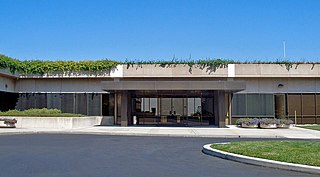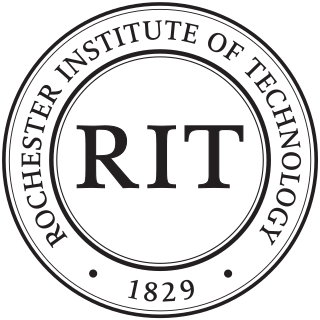Related Research Articles

A computer mouse is a hand-held pointing device that detects two-dimensional motion relative to a surface. This motion is typically translated into the motion of a pointer on a display, which allows a smooth control of the graphical user interface of a computer.

PARC is a research and development company in Palo Alto, California. Founded in 1969 by Jacob E. "Jack" Goldman, chief scientist of Xerox Corporation, the company was originally a division of Xerox, tasked with creating computer technology-related products and hardware systems.

Rochester Institute of Technology (RIT) is a private research university in the town of Henrietta in the Rochester, New York, metropolitan area. The university offers undergraduate and graduate degrees, including doctoral and professional degrees and online masters as well.
Avadis "Avie" Tevanian is an American software engineer. At Carnegie Mellon University, he was a principal designer and engineer of the Mach operating system. He leveraged that work at NeXT Inc. as the foundation of the NeXTSTEP operating system. He was senior vice president of software engineering at Apple from 1997 to 2003, and then chief software technology officer from 2003 to 2006. There, he redesigned NeXTSTEP to become macOS. Apple’s macOS and iOS both incorporate the Mach Kernel, and iPadOS, watchOS, and tvOS are all derived from iOS. He was a longtime friend of Steve Jobs.

Bob Wallace was an American software developer, programmer and the ninth Microsoft employee. He was the first popular user of the term shareware, creator of the word processing program PC-Write, founder of the software company Quicksoft and an "online drug guru" who devoted much time and money into the research of psychedelic drugs. Bob ended his Usenet posts with the phrase, "Bob Wallace ."

Chester Gordon Bell is an American electrical engineer and manager. An early employee of Digital Equipment Corporation (DEC) 1960–1966, Bell designed several of their PDP machines and later became Vice President of Engineering 1972–1983, overseeing the development of the VAX. Bell's later career includes entrepreneur, investor, founding Assistant Director of NSF's Computing and Information Science and Engineering Directorate 1986–1987, and researcher emeritus at Microsoft Research, 1995–2015.

Madhu Sudan is an Indian-American computer scientist. He has been a Gordon McKay Professor of Computer Science at the Harvard John A. Paulson School of Engineering and Applied Sciences since 2015.

Michael Hartley Freedman is an American mathematician, at Microsoft Station Q, a research group at the University of California, Santa Barbara. In 1986, he was awarded a Fields Medal for his work on the 4-dimensional generalized Poincaré conjecture. Freedman and Robion Kirby showed that an exotic ℝ4 manifold exists.
James F. Blinn is an American computer scientist who first became widely known for his work as a computer graphics expert at NASA's Jet Propulsion Laboratory (JPL), particularly his work on the pre-encounter animations for the Voyager project, his work on the 1980 Carl Sagan documentary series Cosmos, and the research of the Blinn–Phong shading model.

Microsoft Research (MSR) is the research subsidiary of Microsoft. It was created in 1991 by Richard Rashid, Bill Gates and Nathan Myhrvold with the intent to advance state-of-the-art computing and solve difficult world problems through technological innovation in collaboration with academic, government, and industry researchers. The Microsoft Research team has more than 1,000 computer scientists, physicists, engineers, and mathematicians, including Turing Award winners, Fields Medal winners, MacArthur Fellows, and Dijkstra Prize winners.

Richard Farris Rashid is the founder of Microsoft Research, which he created in 1991. Between 1991 and 2013, as its chief research officer and director, he oversaw the worldwide operations for Microsoft Research which grew to encompass more than 850 researchers and a dozen labs around the world.

Kai-Fu Lee is a Taiwanese computer scientist, businessman, and writer. He is currently based in Beijing, China.
Alto Trek is a computer game, developed by Gene Ball and Rick Rashid for the Xerox Alto while they were graduate students at the University of Rochester during the late 1970s. It is one of the first networked multiplayer games.

ConferenceXP is a free and open source video conferencing platform designed to address the needs of academic distance learning / multi-institutional instruction and advanced collaboration scenarios.

Andrew Blake FREng, FRS, is a British scientist, former laboratory director of Microsoft Research Cambridge and Microsoft Distinguished Scientist, former Director of the Alan Turing Institute, Chair of the Samsung AI Centre inCambridge, Honorary Professor at the University of Cambridge, Fellow of Clare Hall, Cambridge, and a leading researcher in computer vision.

Jonathan Grudin is a principal design researcher at Microsoft and affiliate professor at the University of Washington Information School working in the fields of human-computer interaction and computer-supported cooperative work. Grudin is a pioneer of the field of computer-supported cooperative work and one of its most prolific contributors. His collaboration distance to other researchers of human-computer interactions has been described by the "Grudin number". Grudin is also well known for the "Grudin Paradox" or "Grudin Problem", which states basically with respect to the design of collaborative software for organizational settings, "What may be in the managers' best interests may not be in the interests of individual contributors, and therefore not used." He was awarded the inaugural CSCW Lasting Impact Award in 2014 on the basis of this work. He has also written about the publication culture and history of human-computer interactions. His book From Tool to Partner, The Evolution of Human-Computer Interaction was published in 2017.
George G. Robertson is an American information visualization expert and Senior Researcher, Visualization and Interaction (VIBE) Research Group, Microsoft Research. With Stuart K. Card, Jock D. Mackinlay and others he invented a number of Information Visualization techniques.

Heung-Yeung "Harry" Shum is a Chinese computer scientist. He was a doctoral student of Raj Reddy. He was the Executive Vice President of Artificial Intelligence & Research at Microsoft. He is known for his research on computer vision and computer graphics, and for the development of the search engine Bing.
Rakesh Agrawal is a computer scientist who until recently was a Technical Fellow at the Microsoft Search Labs. Rakesh is well known for developing fundamental data mining concepts and technologies and pioneering key concepts in data privacy, including Hippocratic Database, Sovereign Information Sharing, and Privacy-Preserving Data Mining. IBM's commercial data mining product, Intelligent Miner, grew out of his work. His research has been incorporated into other IBM products, including DB2 Mining Extender, DB2 OLAP Server and WebSphere Commerce Server, and has influenced several other commercial and academic products, prototypes and applications. His other technical contributions include Polyglot object-oriented type system, Alert active database system, Ode, Alpha, Nest distributed system, transaction management, and database machines.

Aaron Halfaker is principal applied scientist at Microsoft Research. He previously served as a research scientist at the Wikimedia Foundation until 2020.
References
- Contributor biography in Emotions in Humans and Artifacts, by Robert Trappl, Paolo Petta, and Sabine Payr. ISBN 0-262-20142-9.
- ↑ Markoff, John (2000-02-28). "Serious About Research, Microsoft Makes Time for a Game". New York Times . Retrieved 2008-03-04.